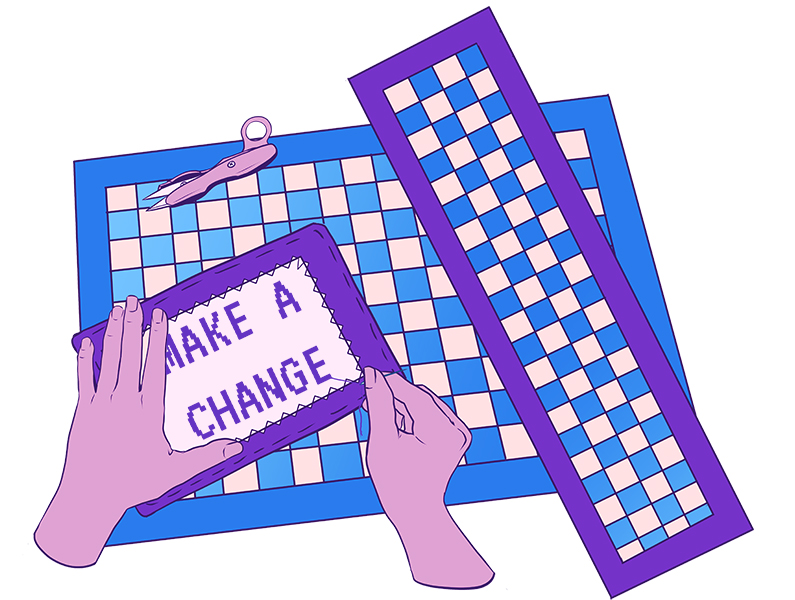By: Mikaela Collins and Andrea Sadowksi
“Craftivism” is a form of gentle protest where craft and activism meet. This movement was made popular by Betsy Greer and Sarah Corbett who have both written manuals on how to be a craftivist. It takes many forms: stitching signs of affirmation to be left in public, putting tiny protest banners on park benches, creating displays of origami cranes to remind parliament of the birds that rely on their protection in World Heritage Sites, and more.
As someone who gets into too many political arguments on Facebook and then usually has to knit for a while to calm down, craftivism is interesting because it de-emphasizes debate and direct confrontation. This is certainly necessary to affect change in some contexts, but can also become part of what Corbett calls “robo-activism” — that is, going through the motions of what activists are supposed to do, even when it’s draining and, to be frank, ineffectual. Corbett started with craftivism because she was burnt out and tired of being surrounded by screaming protestors and negative energy while trying to affect positive change. However, before visions of special snowflakes start dancing in your head — “What, you can’t put up with a little discomfort for the sake of the greater good?” — consider some reasons why alternatives are important.
Crafts are accessible for introverted people who want to make a difference, but don’t know where to start and are alienated in loud, conflict-driven activist spaces — this can also happen due to cultural differences. People with disabilities are routinely excluded, since lots of activities associated with traditional activism involve standing, walking, not eating or sleeping, or demand on-the-spot emotional and intellectual processing skills that not everyone has. But, craftivism can be valuable for all activists.
“A gentle approach to life is an active one — it’s not about being passive and letting the world go by. To engage with people gently is to be thoughtful about your actions, consider carefully the most effective approach to each situation, and keep an eye on the details so nothing is neglected or rushed,” Corbett said in her book A Little Book of Craftivism.
Crafting creates a space for everyone to reflect on issues privately rather than telling and being told things; it demands that you slow down and make many repetitive motions. This allows anger to subside and for craftivists to engage with issues on a more personal level.
The public nature of craftivism, when crafts are displayed, and the way it binds up activism into objects also lets people on the receiving end interact with it differently than they do in a confrontation with another person. Corbett created a campaign called “shop-dropping” to address concerns about fast fashion. It is the opposite of shoplifting, and involves placing a handmade mini scroll in the pockets of clothes in stores that will soon be bought by a consumer. These mini scrolls have a message about the people who made the clothes, and are designed to provoke thought in a natural way rather than preaching or shaming. This again takes pressure off the activist, and allows space for private, judgement-free reflection.
Craftivism also calls into question the line between art, which has long been considered a valid form of political comment and protest, and crafting, which has traditionally been women’s household work, and classified as either mundane and functional, or purely decorative. I think this comes from the fact that a lot of crafting is more structured than traditionally elevated forms of art like sculpting, painting, and drawing — quilting, embroidery, knitting, and cross-stitch rely on patterns and repetition. The devotion that goes into crafting isn’t always as clear from looking at the finished product — a shawl, a cross-stitch, a log cabin quilt — as it is from a canvas painted with bold strokes of colour or lovingly-rendered realism. Among knitters, there is a superstition: never knit a sweater for your boyfriend, because he’ll leave you before it’s done. Some people have posited that this is because significant others will get scared off by how much time and commitment goes into something as simple as a sweater. Political art is usually intended to stand on its own through visual impact, which is granted by the relative freedom of expression that free-form mediums allow; the message is in the finished product. With craftivism, the message is sometimes evident in the finished product, but can almost always be inferred from the time it takes to make it by making hundreds or thousands of stitches. A great piece of political art could just be a red splash on a white canvas that takes two seconds to do, but political crafts by their very nature take more time, and that’s where the passion behind them is evident — especially when those crafts are placed in public with the knowledge that they might be destroyed, damaged, or lost.
I think this may also be what underpins craftivism’s gentle, effective persuasiveness: activism as something which creates something tangible, and those tangible artifacts as products of love, care, and attention. Craftivism is not a replacement for any other form of activism — we need people to march and shout and fight — but it is a valuable alternative, uniquely situated to change minds when debate fails and save people from the burnout that plagues modern activists.
If you’re interested in getting into craftivism and giving a new craft a try, my personal recommendation is cross-stitch — it’s embroidery on a grid system. The materials are cheap, and free patterns are easy to find. Or, take a look on Corbett’s website for more ideas, especially if you want to be part of a larger campaign.
Illustrations: Kayt Hine/The Cascade


